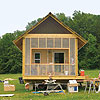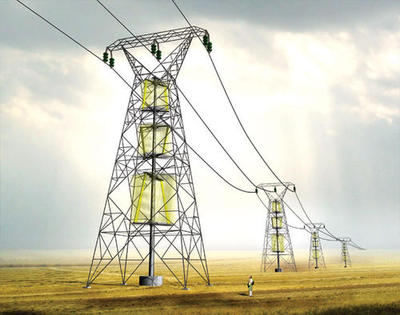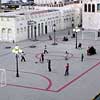built
Bricks and Mortars

While the conflict in Israel and Palestine is a war for dominance, territory, hearts and minds, it is also a war on, and of, the built environment: bulldozing and bombing homes, laying and rerouting roads, checkpoints, the separation wall, and, of course, the settlements.
After the Israeli assault on Gaza that began in December 2008, the Israeli army banned the import of cement. This is particularly pressing since homes, hospitals, schools, water networks cannot be rebuilt.
While some are designing around the ban, developing mud brick architecture and off-grid lighting systems, other activists have flouted the ban sending Gaza cement themselves. And though Israel eased a total ban on construction materials in late July, only 41 truckloads of construction materials were allowed to enter Gaza in 2009. Thousands more are needed.
Last week, on the anniversary of the assault, a group of sixteen human rights and humanitarian organizations accused the international community of betraying the people of Gaza by failing to end the Israeli blockade. Meanwhile, the Western media has not only ignored demonstrations within Israel and without, but even softened the impact of the blockade.
Update 1/6/10: Al Jazeera has another angle on design, the blockade, and the built environment: a write-up of graffiti culture in Gaza. Without access to uncensored news, some activists have turned to graffiti — and were even occasionally sponsored, supplied, and trained by Hamas or Fatah. (via)
 Metropolis looks at the state of the Rural Studio, Auburn University’s architecture program where students design and build for the rural poor in Alabama. After the passing of its founder, the program has shifted focus from building flamboyant, one-off structures to designing an affordable housing template and facilitating financing. It’s never been clear to me how much the communities they build for actually participate in the design process, but I like the new direction.
Metropolis looks at the state of the Rural Studio, Auburn University’s architecture program where students design and build for the rural poor in Alabama. After the passing of its founder, the program has shifted focus from building flamboyant, one-off structures to designing an affordable housing template and facilitating financing. It’s never been clear to me how much the communities they build for actually participate in the design process, but I like the new direction. Roger K. Lewis in The Washington Post: “The Wall Street Journal got into the game recently with a report on concepts by four architectural firms that the newspaper asked to imagine the ‘Green House of the Future.’… Speculating about visionary green houses is tantalizing, but much greater benefits accrue at a larger scale.… Focusing on hypothetical designs of free-standing houses can even be a distraction.… No matter how green individual homes are, suburban sprawl is intrinsically anti-green. It generates infrastructure inefficiency; car dependency and rising fossil fuel demand; carbon-emitting, time-wasting road congestion; and, despite availability of inexpensive land at ever-greater distances from jobs, escalating development, construction and public service costs.… Transforming neighborhoods, buildings and infrastructure to accommodate new functions may be the best way for architects and the real estate industry to help create a greener planet.”
Roger K. Lewis in The Washington Post: “The Wall Street Journal got into the game recently with a report on concepts by four architectural firms that the newspaper asked to imagine the ‘Green House of the Future.’… Speculating about visionary green houses is tantalizing, but much greater benefits accrue at a larger scale.… Focusing on hypothetical designs of free-standing houses can even be a distraction.… No matter how green individual homes are, suburban sprawl is intrinsically anti-green. It generates infrastructure inefficiency; car dependency and rising fossil fuel demand; carbon-emitting, time-wasting road congestion; and, despite availability of inexpensive land at ever-greater distances from jobs, escalating development, construction and public service costs.… Transforming neighborhoods, buildings and infrastructure to accommodate new functions may be the best way for architects and the real estate industry to help create a greener planet.”
Think of the Children
In my bloggy readings, I keep finding stories of monuments and memorials sold on infantilism, using the lens of “childhood” to conjure an air of authenticity and gravitas.
 The New Yorker on Santiago Calatrava:
The New Yorker on Santiago Calatrava:
“In Liège, Belgium, Calatrava was one of seven contestants in an architectural competition to design a high-speed-train station. His rivals came in teams, armed with examples of their past work; Calatrava showed up alone, with his paintbrush [and watercolors], and won the commission. In January, 2004, while presenting his proposal for a new PATH transit hub for the World Trade Center site, Calatrava drew in chalk a child releasing a bird from her hands, thus conveying the genesis of the design, in which a pair of glass-and-steel canopies would arch over the sidewalks of lower Manhattan, like outstretched wings.”
The Washington Post on Ralph Appelbaum:
“When he took on the task of designing a presidential library for former Nigerian president Olusegun Obasanjo, for example, he proposed focusing the displays on the question, ‘What does it take to make a Nigerian child?’ It’s an unanswerable question, but it provided the necessary aha moment that made it all come together, a positive theme that finesses some of the philosophical problems of a presidential library in a country riven by corruption, violence, and religious, ethnic, linguistic and economic divisions.”
The Independent on Daniel Libeskind and his World Trade Center design:
“But Libeskind, a Polish American who now lives in Berlin, captured the hearts of New Yorkers when he appeared live on CNN during the final stages of the competition and said: ‘Like so many others, I arrived by ship in New York harbour as a teenager and as an immigrant. The Statue of Liberty and the Manhattan skyline made an unforgettable impression, and this scheme is all about that.’ ‘The minute he said that, he had the job,’ says Doris Saatchi, the New York art collector. ‘It’s not showmanship. He just expresses emotion so well.’”
Meanwhile, actual kids are moving adults to make responsible policy. See Democracy Now!: Testimony of 12-Year-Old with Two Moms Moves Some Vermont Legislators to Support Gay Marriage Bill.
 Curated by the Canadian Centre for Architecture, a list of 99 creative, public interventions for civic improvement. See, for instance, Illicit Stencil Saves Cyclists and Reclaim Vacant Lot with What City’s Got. ( via ag, gi)
Curated by the Canadian Centre for Architecture, a list of 99 creative, public interventions for civic improvement. See, for instance, Illicit Stencil Saves Cyclists and Reclaim Vacant Lot with What City’s Got. ( via ag, gi)
page 20 19 18 17 16 15 14 13 12 11 10 9 8 7 6 5 4 3 2 1 Older »

